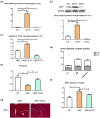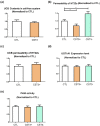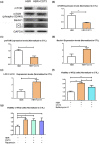CST3 alleviates bilirubin-induced neurocytes' damage by promoting autophagy
- PMID: 37854583
- PMCID: PMC10579785
- DOI: 10.1515/tnsci-2022-0314
CST3 alleviates bilirubin-induced neurocytes' damage by promoting autophagy
Abstract
High concentrations of unconjugated bilirubin (UCB) have toxic effects. The aim of our study was to find a way to elevate UCB tolerance or inhibit its toxicity in neurocytes. It has been reported that cystatin C (CST3) concentrations have a significant positive correlation with total bilirubin (TB) levels and a negative correlation with albumin levels. In addition, CST3 can directly bind UCB, decrease human umbilical vein endothelial cells' permeability, improve blood-brain barrier integrity after ischemic brain injury in mice, and induce autophagy. We hypothesized that CST3 could increase the solubility of UCB, decrease permeability of neurocytes, induce autophagy of neurocytes, and alleviate bilirubin-induced damage. To verify our hypothesis, we measured TB and conjugated bilirubin levels, and the permeability and autophagy of neurocytes treated with UCB and CST3. Our findings suggest that CST3 can protect against UCB-induced damage in neurocytes and that autophagy played an important role in this process.
Keywords: autophagy; cystatin C; hyperbilirubinemia; unconjugated bilirubin.
© 2023 the author(s), published by De Gruyter.
Conflict of interest statement
Conflict of interest: Authors state no conflict of interest
Figures




Similar articles
-
Cystatin C alleviates unconjugated bilirubin-induced neurotoxicity by promoting bilirubin clearance from neurocytes via exosomes, dependent on hepatocyte UGT1A1 activity.Transl Neurosci. 2024 Oct 14;15(1):20220357. doi: 10.1515/tnsci-2022-0357. eCollection 2024 Jan 1. Transl Neurosci. 2024. PMID: 39434773 Free PMC article.
-
Time-dependent dual effects of high levels of unconjugated bilirubin on the human blood-brain barrier lining.Front Cell Neurosci. 2012 May 10;6:22. doi: 10.3389/fncel.2012.00022. eCollection 2012. Front Cell Neurosci. 2012. PMID: 22590454 Free PMC article.
-
The activation of autophagy protects neurons and astrocytes against bilirubin-induced cytotoxicity.Neurosci Lett. 2017 Nov 20;661:96-103. doi: 10.1016/j.neulet.2017.09.056. Epub 2017 Sep 28. Neurosci Lett. 2017. PMID: 28965934
-
Bilirubin chemistry and metabolism; harmful and protective aspects.Curr Pharm Des. 2009;15(25):2869-83. doi: 10.2174/138161209789058237. Curr Pharm Des. 2009. PMID: 19754364 Review.
-
Contribution of inflammatory processes to nerve cell toxicity by bilirubin and efficacy of potential therapeutic agents.Curr Pharm Des. 2009;15(25):2915-26. doi: 10.2174/138161209789058165. Curr Pharm Des. 2009. PMID: 19754368 Review.
Cited by
-
Cystatin C alleviates unconjugated bilirubin-induced neurotoxicity by promoting bilirubin clearance from neurocytes via exosomes, dependent on hepatocyte UGT1A1 activity.Transl Neurosci. 2024 Oct 14;15(1):20220357. doi: 10.1515/tnsci-2022-0357. eCollection 2024 Jan 1. Transl Neurosci. 2024. PMID: 39434773 Free PMC article.
References
-
- Sullivan JI, Rockey DC. Diagnosis and evaluation of hyperbilirubinemia. Curr Opin Gastroenterol. 2017;33(3):164–70. - PubMed
-
- França de Souza D, Alonso MA, Brito MM, Meirelles MG, Francischini MCP, Nichi M, et al. Oxidative state in equine neonates: anti- and pro-oxidants. Equine Vet J. 2021;53(2):379–84. - PubMed
-
- Hansen TWR, Wong RJ, Stevenson DK. Molecular physiology and pathophysiology of bilirubin handling by the blood, liver, intestine, and brain in the newborn. Physiol Rev. 2020;100(3):1291–1346. - PubMed
-
- Li S, Huang H, Zhang Y, Li L, Hua Z. Bilirubin induces A1-like reactivity of astrocyte. Neurochem Res. 2023;48(3):804–15. - PubMed
LinkOut - more resources
Full Text Sources
Miscellaneous
